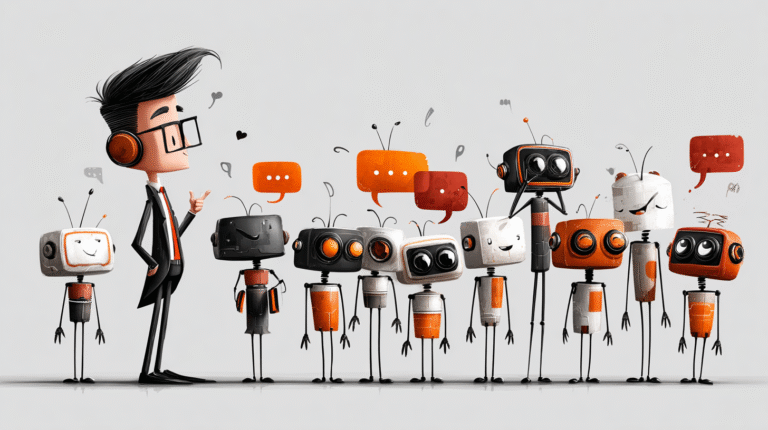Streamline Your Workflow: AI for Creative Marketers
AI isn’t going to replace creative marketers – but creative marketers who use AI effectively will transform how they work. The most interesting opportunities come from connecting AI tools with automation platforms to create intelligent content systems that handle repetitive tasks while preserving your creative control.
The building blocks of these systems are simpler than you might think. You need three main components: AI models that generate and process content, automation tools that connect different services, and your existing marketing stack. When you combine these effectively, you can create powerful workflows that save hours of work each week.
Let’s look at what’s possible right now with tools like Make.com and n8n, combined with AI APIs.
Content Generation and Repurposing
You can automatically turn one piece of content into multiple formats. A single blog post can become social media updates, email newsletters, and video scripts, each optimized for its platform. The AI understands context and adapts the tone and format accordingly, while automation tools handle the distribution.
Campaign Ideation and Planning
AI can analyze your best-performing content, customer feedback, and market trends to suggest campaign themes and content ideas. Set up automated systems to monitor analytics, social media engagement, and customer interactions, then use AI to spot patterns and opportunities.
Personalization at Scale
Create dynamic content that adapts to different audience segments. Your automation system can pull data from your CRM, use AI to generate personalized variations, and deliver them through your marketing channels. This works particularly well for email campaigns and ad copy.
Content Calendar Management
Automate the tedious parts of content planning. Your system can suggest optimal posting times, maintain a balanced mix of content types, and even draft social media calendars based on your strategy and past performance data.
Quality Control and Brand Consistency
Build automated checks into your content workflow. AI can review texts for brand voice, style guidelines, and common errors, while automation tools ensure everything follows your approval process. You stay in control while eliminating manual checks.
Analytics and Optimization
Set up systems that automatically analyze content performance, identify what works best, and adjust future content accordingly. This creates a feedback loop that continuously improves your results.
Planning Your First AI Content Automation: A Practical Guide
The secret to successful content automation is identifying the right process to automate first. Let me show you how to spot these opportunities and turn them into practical automation plans.
Start With What You Already Do Well
Pull up your content calendar and look at what you create regularly. Which content consistently performs well? These proven processes are perfect automation candidates because you already know what good results look like.
Open a blank document and list your regular content tasks. For each one, note:
- How often you do it
- How long it typically takes
- Whether the process is consistent or varies significantly each time
- What determines success for this content
This gives you a clear picture of where automation could save significant time while maintaining quality.
Find Your Quick Wins
The best first automation project has three characteristics:
- A clear, repeatable process
- Minimal risk if something goes wrong
- Measurable results
For example, if you regularly turn blog posts into social media content, that’s an ideal candidate. The process is straightforward, you can review posts before they go live, and you can easily measure engagement.
Map Your Current Process
Take your chosen task and break it down into steps. Be specific – pretend you’re writing instructions for someone who’s never done this before.
Here’s what this might look like for blog-to-social content:
- Read the new blog post
- Identify key points and quotes
- Create variations for different platforms
- Add relevant hashtags
- Schedule posts across the week
- Track performance
Now you can see which steps could benefit from automation. Maybe AI could extract key points while you focus on crafting the perfect hooks for each platform.
Design Your Ideal Workflow
Sketch out how your automated process should work. Don’t worry about technical details yet – focus on what you want to achieve.
Your workflow might look like this:
- New blog post triggers the system
- AI extracts key points and suggests social posts
- You review and edit the suggestions
- Approved posts are scheduled automatically
- Performance data feeds back into the system
This becomes your blueprint for choosing tools and setting up the actual automation.
Choose Your Tools
Now you can match your needs to specific tools. For our blog-to-social example:
- An automation platform (Make.com or n8n)
- AI for content generation (create a developer account with Anthropic and or OpenAI)
- Your social media scheduling tool
- Analytics tools you already use
Start Small and Iterate
Begin with a simple version of your automation. Maybe just generate social post drafts for one platform first. Test thoroughly, adjust based on results, and then expand to more platforms or add more sophisticated features. You’ll notice that you’ll spend a good amount of time getting your prompts just right.
Track these metrics as you test:
- Time saved compared to manual process
- Content quality (set specific criteria)
- Performance metrics for the content
- Any issues or manual interventions needed
Build in Safety Nets
Even simple automations need safeguards. Add review steps before content goes live and monitor the system regularly. Set up alerts for potential issues and have a backup plan for when things go wrong.
Also, don’t try to automate too much at once. Focus on one clear process and get it working well before adding complexity. Keep your first automation simple enough that you can easily monitor and adjust it.







